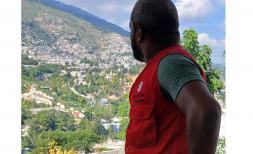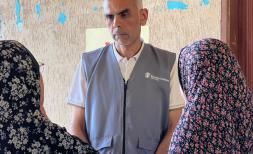How does the climate crisis make more children go hungry?

By now, we all know that the climate crisis is getting rapidly worse, and the number of climate-related disasters is increasing all around the world. But did you know that this has a huge impact on children’s hunger and malnutrition?
What’s happening?
Experts have linked rising temperature to a rise in both the frequency and intensity of extreme weather events such as storms, fires, floods and droughts. The number of climate-related disasters has tripled in the past 30 years.
Climate change is increasingly having a negative impact on water resources for food production as it alters the rates of precipitation and evaporation as well as groundwater levels. 1.8 billion people—just under one-quarter of the world population—live in water-stressed areas, and this number is expected to grow to about half of the world population by 2030.
The number of climate-related displacements has also been increasing, with whole families moving from their hometowns to a place with greater access to food, water, and safe land.
How does this increase hunger?
Large numbers of people in some of the world’s poorest regions depend on agriculture for their livelihoods, particularly in South Asia and Sub-Saharan Africa —regions which have high concentrations of poverty and hunger. Agriculture is hugely dependent on rainfall and is susceptible to even small changes in temperature.
Floods can destroy crops, strip away topsoil and cause landslides. As temperatures rise, research has suggested that crop production will get more and more difficult. According to one study, corn yields will decrease by an average of 7.4% for every degree Celsius of warming.
But just as too much rain can affect crops, too little can be just as bad. Droughts can kill off families’ livestock, which they rely on for food, income, and nutrition. And worse of all, these climate crises often come in short succession: children and their families can’t cope as they have no time to recover before the next crisis hits.
Climate change can also worsen the nutritional value of the food that is cultivated. Recent studies show that higher CO2 concentrations reduce the protein, zinc, and iron content of crops. By 2050 an estimated additional 175 million people could be deficient in zinc and an additional 122 million people could experience protein deficiencies.
How does Save the Children help?

Climate change has affected children like 4-year-old Amburo*, above, and her 9-year-old sister Hani*. Their family were displaced by drought and locust infestations, and now live in a camp in Somalia where they access our services.
They originally arrived in the camp during the 2017 drought when they lost almost all their livestock – their primary source of food and income. They lived in the camp for two years and then returned to the countryside when conditions improved. But then the current drought intensified, their remaining goats started to suffer because they didn’t have enough to eat, and a locust plague decimated their small farm.
Amburo, Hani, and the family returned to the camp where life is incredibly difficult. They do not have a proper shelter and live in a make-shift structure made from salvaged materials. Their mother Uba goes to the market to look for cleaning jobs but with the drought affecting people’s incomes, jobs are scarce and Uba struggles to provide food for her children.
The children go to the Child Friendly Space we run and school we support at the camp. The family also accesses free healthcare at a health centre we support and Amburo was treated for malnutrition at the stabilisation centre where we provide funding and training.
Families like Amburo’s have experienced an increasing number of climate-related disasters over the last few decades, ranging from long-lasting droughts to devastating floods, locust infestations and even cyclones, sometimes all experienced in the same region within months.
In 2021, Somalia is facing yet another drought, which is pushing the number of children and adults who need critical support to 5.9 million – a third of the population and an increase of 700,000 people compared to 2020.
Our assessment from February 2021 found that more than 70% of families surveyed didn’t have access to clean drinking water and that more than 50% didn’t have enough food to eat.
We continue to prioritise the needs of the children most affected by these complex crises, and are ramping up our humanitarian response in Somalia and other regions affected by the climate crisis. We’re providing water for drought-stricken communities; therapeutic food for malnourished children; emergency healthcare for pastoralist and hard-to-reach communities; cash and voucher assistance to families facing economic stress; and student food and water programmes to support schools to stay open. We're also continuing to work with local governments to build the long-term resilience of communities to cope with climate shocks.
If you’d like to be a part of this effort to protect children from climate crises and hunger, donate now.
*names changed to protect identities







